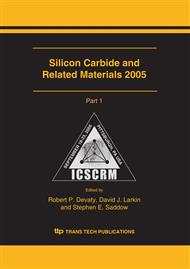p.935
p.949
p.955
p.961
p.967
p.971
p.975
p.979
p.983
Improved 4H-SiC MOS Interfaces Produced via Two Independent Processes: Metal Enhanced Oxidation and 1300°C NO Anneal
Abstract:
Two previously reported MOS processes, oxidation in the presence of metallic impurities and annealing in nitric oxide (NO), have both been optimized for compatibility with conventional 4H-SiC DMOSFET process technology. Metallic impurities are introduced by oxidizing in an alumina environment. This Metal Enhanced Oxidation (MEO) yields controlled oxide thickness (tOX) and robustness against high temperature processing and operation while maintaining high mobility (69 cm2/Vs) and near ideal NMOS C-V characteristics. Raising the NO anneal temperature from 1175oC to 1300oC results in a 67% increase in the mobility to 49 cm2/Vs with a slight stretch-out in the NMOS C-V. Both processes exhibit a small 30% mobility reduction in MOSFETs fabricated on NA = 1x1018 cm-3 implanted p-wells. The low field mobility in the MEO MOSFETs is observed to increase dramatically with measurement temperature to 160 cm2/Vs at 150oC.
Info:
Periodical:
Pages:
967-970
Citation:
Online since:
October 2006
Price:
Сopyright:
© 2006 Trans Tech Publications Ltd. All Rights Reserved
Share:
Citation:


